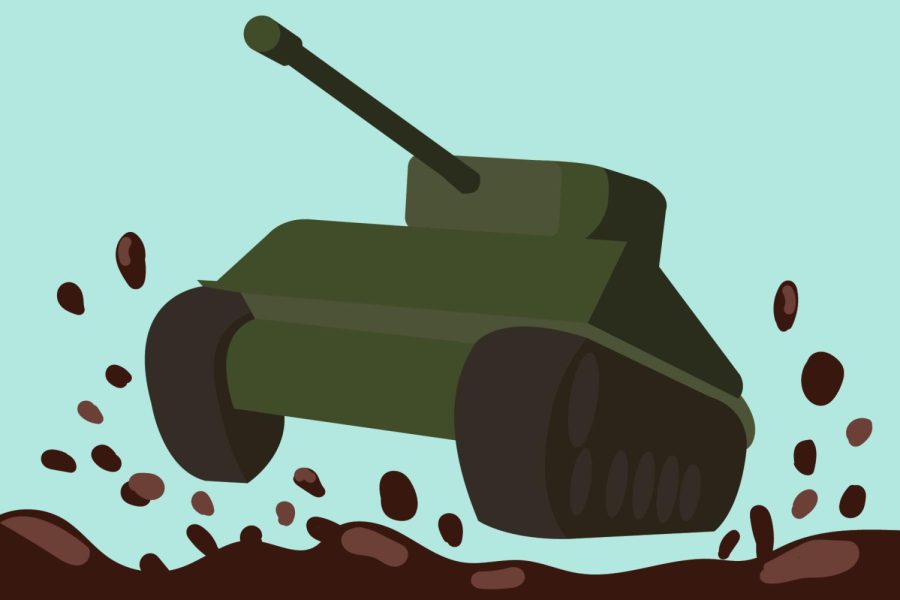Student’s Experience with Reimagining “Tanks!”
This semester at UW-Platteville’s Game Development Club, a project is underway for a reimagined version of Wii Play’s minigame “Tanks!” To accomplish this, members, including myself, work as a team with various tasks.
Before I discuss the club’s remake, I am going to explain the original game. According to MobyGames, a video game information website, the “Tanks!” utilizes a Wii Remote as the main controller. It aims with motion controls, drops mines and fires missiles with button inputs, and drives the tank with the remote’s control pad. Once the player or players destroy all enemy tanks, they continue to the next level.
I remember playing the game during my childhood. The game itself is not complex, but there are different strategies on how to play. The player thinks of ways to move their miniature tank in a level’s toy-like stage around wooden block walls. This involves planning when to attack and defend, as if it were chess.
Regarding the team’s re-creation, Lincoln Schroeder, the president, said his team of ten members is working toward bringing the same gameplay experience from the Wii to the PC. This means that the reimagined version will allow a single player to control the tank with a keyboard instead of a Wii Remote. Douglas Selent, the club advisor, said students have been working on “different types of projectile effects” and “(the ability for tanks) to bounce off of (walls).”
So far, I have done two tasks for the club. The first was creating a model for landmines. The original “Tanks!” had the landmine as a single yellow and red flashing dot, but I played around with the concept of toys. The creative side of me based the landmine’s model on the one used in “Resident Evil Village.” The gear-shaped plate on the game’s model reminded me of toy gears a baby plays with. For my model, I made a metal-rusted texture for the base, a yellow gear to make the landmine toy-like and a small red button that will flash when exploding. It captures the essence of the flashing dot from the Wii game yet carries the toy and army theme.
The second task was creating a concept for the pause menu’s background. I created a version that has a similar style to one from Wii Play. When the player pauses the game, they will have the options to continue, start over or quit. Each option will be in a stretch pro font, and they will be inside of a gray text box with a dark teal outline. The gray turns into a lighter teal when the player is going to select an option.
Schroeder works with various students when leading others on the project. He guides members on the club’s objectives and offers any assistance if needed. When asked if there were any reasons why students would not want to join the club, such as being intimidated, he said, “We try to be as inclusive as possible. There are tutorials and everything, and if a task is too hard, we’re free to help (students) out.”
Selent adds on to Schroeder’s comment, “We actually had about a month of tutorials at the start of the semester because we know we have a lot of (students) coming in who might be intimidated by lack of experience.”
The technical lead, Ty Staszak, is another leader who helps run the club. As for his reasoning to be the tech lead, he said, “I chose (the position) because I like to focus on the programming and … the game logic of the games that (the team does).”
Since my junior year of high school, I self-taught myself Blender, a software program that involves creating and animating 3D models. When the global pandemic hit, this passion of mine sparked and over time my skills grew. At first, I had no clue about how to do anything, but through tutorials and practice, I gained a fondness to create within programs. It is what inspired me to major in Computer Science, to continue my passion for creating models and graphic art and to participate in the Game Development Club.
The club itself does not require one to have any experience in video game creation, as any incoming student can develop new skills over time. When asked how others can participate, Staszak said, “You can go for the programming side, you can go for the artistic side, you can go from the creative side … Even if you don’t think you’re much into programming, (there is) something out there that you can give for game development.”
This true for what I provide for the team. Once there is no longer a need to create models and graphic art for the project, I plan on learning how to program with Unity, a game engine software where developers test and develop video games. It is with Unity that developers create video games, such as Subnautica and Cuphead. I plan on exploring new ways to show my creativity as a member of the Game Development Club. Doing so will let me enjoy the process of developing video games, and it will benefit my education on programming languages.
The U.S. Bureau of Labor Statistics does not include the occupation of game development, but it does fall into the category of arts and design occupations, where a 4% incease in jobs between 2020 and 2030 is expected. Other game development skills, such as programming, fall into the computer and information technology occupations which are expected to increase by 13% in those same years.




